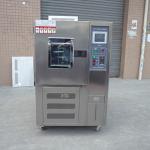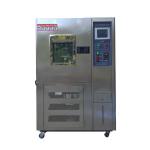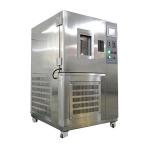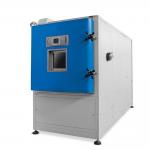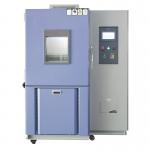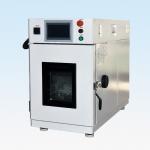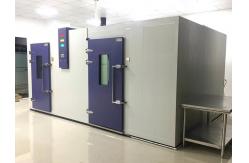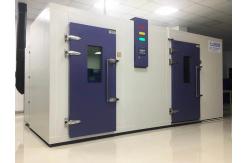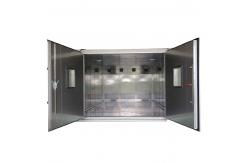In the realm of industrial and research applications, the ability
to accurately simulate and control a wide range of climate
conditions is essential. The Customization Walk-in Climate
Environment Simulation Test Chamber stands as a remarkable
solution, providing a large-scale and highly adaptable platform for
testing various products and materials. This custom-designed walk-in chamber is engineered to create and
maintain precise climate environments, including temperature,
humidity, and sometimes even other factors such as air pressure and
air flow. It serves a diverse array of industries, such as
aerospace, automotive, electronics, pharmaceuticals, and materials
science. The primary purpose is to subject full-scale products,
large assemblies, or a significant quantity of samples to realistic
and extreme climate scenarios. This allows manufacturers and
researchers to comprehensively evaluate performance, durability,
and quality. By replicating the most challenging environmental
conditions that products may encounter during their lifecycle, from
the frigid cold of polar regions to the sweltering heat and
humidity of tropical climates, the chamber enables optimization of
product designs, determination of reliable storage and
transportation conditions, and ensures compliance with stringent
industry standards and regulations. - Spacious and Sturdy Construction
- The chamber is constructed with a robust framework, typically made
of heavy-duty steel, ensuring structural integrity and the ability
to withstand the rigors of continuous use and extreme climate
conditions. The exterior is designed to be durable and resistant to
environmental factors, protecting the internal components and
maintaining a stable testing environment. The interior is lined
with a non-reactive and smooth surface, such as stainless steel or
a specialized polymer, to prevent any interaction between the
chamber and the tested items. The walk-in design offers a large
volume, which can be customized to meet specific requirements,
ranging from a few cubic meters to several dozen cubic meters. This
ample space allows for testing of bulky equipment, entire vehicle
components, or large batches of products. The door of the chamber
is engineered for a tight seal, featuring a reliable locking
mechanism and a heavy-duty gasket. It also includes a large viewing
window, usually made of tempered glass with anti-fog and
anti-scratch properties, enabling continuous visual monitoring of
the testing process without disturbing the internal climate.
- Precision Climate Control Systems
- Temperature Control: The temperature control system is highly
accurate and can maintain a wide temperature range, typically from
-70°C to +150°C, with an accuracy of ±0.3°C. It utilizes advanced
refrigeration and heating technologies, along with a sophisticated
feedback loop and multiple temperature sensors strategically placed
throughout the chamber. This ensures uniform temperature
distribution, even in large volumes, and rapid temperature change
capabilities, essential for efficient testing. The system also has
built-in safety features to prevent overheating or overcooling,
protecting both the tested items and the chamber itself.
- Humidity Control: The humidity control system is equally precise,
capable of adjusting the relative humidity from 5% to 95% RH, with
an accuracy of ±2% RH. The chamber is equipped with a
high-efficiency humidifier and dehumidifier, which work in harmony
to achieve rapid and accurate humidity adjustments. Special care is
taken to prevent condensation, which could affect the test results
and damage the samples. The system also features a dew point
control function, which is crucial for maintaining the correct
moisture balance in the chamber.
- Programmability: The chamber's control panel is highly
programmable, allowing users to create and store complex climate
profiles. This enables the simulation of a wide variety of
environmental conditions, from simple static settings to cyclic and
stepwise changes. For example, it can mimic the long-term climate
variations that a product might experience during a multi-year
outdoor exposure or the rapid and extreme changes during a weather
event. The control panel is user-friendly and intuitive, with a
clear display that shows the current temperature, humidity, and the
status of the testing program.
- Advanced Instrumentation and Data Acquisition
- The chamber is outfitted with a comprehensive suite of sensors.
Temperature sensors are distributed evenly to detect any
temperature gradients and ensure a homogeneous thermal environment.
Humidity sensors provide real-time data on the relative humidity
levels. Additionally, other sensors may be incorporated, such as
air pressure sensors and air flow sensors, depending on the
specific testing requirements. These sensors are connected to a
state-of-the-art data acquisition system that records and stores
all the measured data. The data can be accessed and analyzed in
real-time or retrieved later for in-depth studies. The data
acquisition system is highly flexible and can be integrated with
external software and databases, facilitating seamless data
transfer and analysis. It can also be configured to send
notifications and reports automatically, saving time and effort for
the users. Additionally, the control panel includes built-in alarms
and safety features that alert users in case of any abnormal
conditions, such as temperature or humidity excursions outside the
set limits, power failures, or equipment malfunctions.
- Volume and Dimensions: The volume of the walk-in chamber can be customized to fit the
specific needs of the user. It can range from a small walk-in size
of a few cubic meters, suitable for testing medium-sized products
or a limited number of samples, to a large industrial-scale chamber
with volumes exceeding 50 cubic meters, capable of accommodating
entire vehicles or large industrial equipment. The external
dimensions are configured to fit within the available space in a
laboratory, factory, or testing facility, taking into account
factors such as access, ventilation, and clearance. The interior
dimensions are carefully designed to optimize the distribution of
climate conditions and ensure that all parts of the tested items
experience consistent environmental parameters.
- Temperature Uniformity: The temperature uniformity within the chamber is maintained
within ±0.5°C. This ensures that all parts of the tested samples or
products experience a similar thermal environment, which is crucial
for obtaining accurate and reliable test results. Even a slight
temperature difference across a large object can lead to different
performance outcomes and inaccurate assessment of its durability.
- Humidity Uniformity: The humidity uniformity is within ±3% RH. This level of
consistency in humidity distribution allows for precise testing of
samples that are sensitive to moisture levels.
- Stability: Both the temperature and humidity stability are excellent, with
minimal fluctuations over time. This allows for long-term testing
and the evaluation of a sample's performance under stable climate
conditions, as well as its ability to withstand changes over
extended periods.
- Accurate Simulation of Complex Climate Conditions
- The primary function of this chamber is to provide a highly
accurate and realistic simulation of specific climate conditions.
By precisely controlling temperature, humidity, and other
parameters, it allows users to evaluate how products and samples
will behave in various real-world situations. For example, in the
aerospace industry, it can test the performance of aircraft
components under extreme temperature and humidity conditions, as
well as simulate the rapid pressure changes experienced during
flight. In the automotive industry, it can assess the durability of
vehicle exteriors and interiors in different climates and weather
conditions, including exposure to rain, snow, and high levels of
sunlight.
- The ability to create complex environmental profiles, such as
cyclic temperature and humidity changes combined with varying air
pressure, is also a valuable function. This can help in uncovering
potential weaknesses or failure points in products that may not be
evident under static or simple climate conditions. For instance, a
product that is exposed to a combination of high humidity, rapid
temperature drops, and changes in air pressure may experience
stress-induced damage over time, and this chamber can accurately
replicate such scenarios.
- Enhanced Product Quality and Research Capabilities
- Through comprehensive testing in the chamber, manufacturers can
identify and address potential issues in their products. If a
product shows signs of degradation or failure under specific
climate conditions, appropriate measures can be taken, such as
modifying the design, changing the material composition, or
improving the manufacturing process. This leads to the development
of more stable and reliable products, reducing the risk of failures
and recalls. In the research field, it allows for the exploration
of new materials and the understanding of their properties under
different climate conditions, which can lead to significant
scientific breakthroughs. For example, materials scientists can
study the behavior of new composites or coatings under extreme
temperature and humidity cycling, leading to the discovery of
materials with improved performance and durability.
- The test chamber also serves as a valuable tool for quality
control. By subjecting products to standardized climate tests,
manufacturers can ensure that their products meet the required
quality and performance standards. This helps in building customer
trust and maintaining a good reputation in the market.
- Compliance with Industry Standards and Regulations
|
